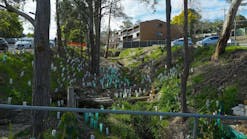About the author: Lauren Baltas is managing editor of SWS. Baltas can be reached at [email protected] or 847.391.1019.
In Southern California, drought fueled the Thomas fire. While the state has longed for rain, potential rainfall is now a threat.
According to the Los Angeles Times, it is the largest wildfire on record in California, burning 281,893 acres. Triggered by strong Santa Ana winds and dry vegetation, reported The Weather Channel, the fire started Dec. 4 and has burned for more than one month. The fire took one life, and the California Department of Forestry and Fire Protection (Cal Fire) reported that it destroyed 1,063 structures.
As of press time, the fire has slowed and is largely contained, but rainfall looms on the horizon. While the state needs gentle rainfall to mitigate the fire and drought, too much rain too quickly will precipitate erosion the state may not be prepared to handle.
“At this point, I’m not really sure if I want it to rain hard or not,” Joshua Haggmark, water resources manager for the city of Santa Barbara, told SWS. “I feel like I’m damned either way as to the outcome.”
Trouble Is Brewing
Having burned away much of the vegetation in the area—including trees and brush—the fire has eliminated the ground cover necessary to prevent sediment removal and erosion should rainfall occur. The desert climate does not improve the situation, Haggmark said, as the sediment is easily mobilized to start. According to Carlos Molina, sales engineer for Soil Retention, exposed soil is easily erodible by rain events.
“Rainwater runoff erodes loose sediments, increasing the risk of debris flow and the potential for landslides,” Molina said. “In severe cases, fires can cause soil surfaces to harden and repel water instead of the rain soaking into the soil.”
Soft rains could provide a much-needed reprieve to the drought-stricken state, but a heavy or long-term rain event could have dangerous results. Areas that are more susceptible to erosion—steep slopes or near waterways—pose risks for mudslides and contaminants entering tributaries and contaminating drinking water. Unfortunately, the region cannot regrow the necessary vegetation to prevent mudslides without a little rain.
Vegetation on the surrounding hills in Southern California has been largely eliminated.
Hello Rain, Goodbye Water
The post-fire erosion creates a domino effect, affecting all aspects of the water industry. Should mudslides occur, the moved earth could close major highways and prevent locals from traveling to work. This possibility is especially detrimental when it concerns government employees. The city of Santa Barbara is working to prevent this occurrence.
Haggmark told SWS that the city is considering plans to transport water and wastewater treatment utility workers to work by boat. If the crews cannot get to the utilities, then the city cannot provide water or wastewater services to its residents. South of Santa Barbara, the city of Ventura is considering installing a satellite office to allow utility workers to work remotely, according to Ron Merckling, public affairs resource manager for the city of Ventura. Even with remote employees, however, the facilities may struggle to run.
“[Mudslides] cut off the highway, potentially impacting power …” Haggmark said. “We have backup generators, but they require refueling every three days, so we would have to make sure that we could get trucks to the city in order to refuel those generators.”
What primarily is an erosion control issue bleeds into drinking water safety. Runoff caused by rainfall after a fire will carry ash and other contaminants; increased sediment, nutrients, and pollutants will run into watersheds, rivers and reservoirs. Post-fire runoff can contain a number of contaminants, many of which derive from materials found in the home—metals, petroleum products, plastics—as well as fire retardants, which are a growing concern in Southern California after the fire. These contaminants enter groundwater, creating additional problems for water utilities and private well owners, the latter of whom may not be aware of the growing danger. Should utilities lack power or utility employees be unable to travel to work, the cities cannot remove these harmful contaminants from the water system.
Runoff and erosion also can potentially alter river movement, harm native species and reduce reservoir storage. Runoff can enter local waterways and eventually end up in larger tributaries. If a reservoir fills with sediment, it is extremely costly to remove it, Haggmark said. The reservoir’s lifespan decreases, and suddenly a major drinking water source is cut off for an area already lacking water resources.
“It’s probably close to $100,000 per acre-ft of silt removed,” Haggmark said. “It’s big bucks, and I would expect we would get at least 1,000 if not 1,500 acre-ft of silt from the fire damage. So that ends up being $150 million.”
Learning from the Zaca Fire of 2007, the city of Santa Barbara determined that it was cheaper to build a desalination plant than remove the silt from the reservoir. There is no cheap solution, but when difficult questions are asked, cities have to act accordingly.
Loss of vegetation can cause dangerous erosion and runoff, affecting the safety of homes and water alike.
What a Guy
To combat post-fire damage, Molina advised stabilization and rebuilding ground cover with three techniques: mulch application, water barrier installation and revegetation. Across Southern California, cities, counties and residents are implementing such features. Some individuals, like Haggmark, have expressed concern about the state’s ability to respond if heavy rain closely follows the fire. With limited reaction time, the results could be problematic.
“We’re just planning to deal with the damages, and the questions have already started to pour out,” Haggmark said.
One company, however, is doing things a little differently. After losing his home in the fires, Doug Allard, managing member of The Wattle Guys, transformed his property, which sits in the middle of the burn zone in Santa Rosa, to produce straw wattles and inlet protection on site. Allard elected to supply products to his immediate neighbors free of charge.
“The first priority we sought was to have perimeter controls installed around the immediate burn area as soon as possible, which we were active on within the first week,” Allard said. “Being in the business, we understood the risks involved and potential for the disaster getting even worse if we were to allow a lot of the materials from the burned area to enter the waterways.”
Allard’s teams prioritized installing straw wattles in the immediate burn area, then installing inlet protection devices to protect storm drains. The Wattle Guys are able to produce these materials on a remote site because they utilize fully self-contained mobile straw wattle production equipment.
With the help of thousands of residents and volunteers from nearby organizations, including a local vineyard and the Clean Water Alliance, and funding from the state Water Quality Control Board, The Wattle Guys donated 50,000 to 75,000 ln ft of straw wattles to homeowners in the area and installed approximately 2,600 drain inlets throughout the city.
“It’s been one of the first opportunities for a lot of property owners to get involved and feel like they’re actually doing something to help protect the environment,” Allard said. “There have been a lot of situations where we’ve worked hand-in-hand with the property owners to install products, and it’s been really heartwarming to see the effect it had on the community. Unbelievable.”
To produce such a high volume of product, The Wattle Guys crew members built the product and volunteers dragged and stacked it for property owners to pick up. Engineers even came to collect product for Cal Fire to use.
“It was an absolute team effort,” Allard said. “I was telling some folks, if you’re feeling down and kind of blue thinking about your property—it gets kind of depressing—come up to the lot and help us drag and stack wattles for an hour or two, and you’ll forget about your burned house … The number of hugs I’ve had … the number of people we positively touched is amazing.”
Editor’s Note: Since this story was written, Southern California experienced heavy rainfall and subsequent mudslides. Mud, debris and boulders swept the hillside. According to NPR, the death toll rose to 20. CNN reported that area residents were still unaccounted for.






